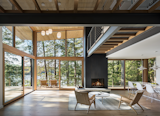A Spectacular Lakeside Retreat in New Hampshire
A family of four was looking for a retreat where they could disconnect from their busy city life back in Boston and embrace the great outdoors. They tapped Concord, Massachusetts–based Murdough Design, an architecture firm whose specialty is creating contemporary residences that engage with nature.
Located on a wooded lot bordering Squam Lake in Center Harbor, New Hampshire, Tom Murdough, principal in charge, and Rob Potish, project manager, designed a three-story, 4,200-square-foot, modern cabin, which was the recipient of 2018 AIA New Hampshire Merit Award for Excellence in Architecture Design.
When designing the house, the architects had to deal with a handful of constraints, like an existing foundation. The previous structure, a 1960s-era cabin, was taken down to the foundation, and the contemporary cabin built in its existing footprint.
"Utilizing the existing foundation was a way of being advantageous, but also created limitations in some ways," says Murdough. "We were able to create a unique building in a conventional footprint."
Embracing the simplistic design of cabins, the getaway took on a basic rectangular form, but it was modified in ways to make it look more dynamic and contemporary with a dark cedar and metal exterior, sloped roofline, and strategically placed windows.
To help the family unplug from city life, the four-bedroom, three-and-a-half-bath lake house was designed to engage with nature. "A big part of a retreat is outdoor living," says Murdough. To create seamless indoor/outdoor spaces, the architects integrated the design of the home with the terrain and surrounding views.
In the kitchen, custom walnut cabinets are paired with stainless-steel countertops and backsplash to help reflect the natural setting. "It captures the coloration of the landscape and the light, which makes it feel larger than it is," says Murdough. "Also, stainless steel is good for kitchens and work environments."
Murdough and Potish did this by positioning decks to take advantage of lake views and sunsets. All primary living spaces—such as the family room, dining area, and kitchen—are placed strategically next to exterior living spaces, with large sliding doors that lead to the great outdoors. "Moving indoors and outdoors is very easy," says Murdough.
While public living spaces are exposed to nature with expansive glass windows and doors, as a counterpoint, private spaces—like bedrooms and bathrooms—are cloistered for privacy. "Those feel more cocoon-like and intimate," says Murdough.
Shop the Look
In private rooms, window openings are smaller with more selective views. "In some ways, [they’re] more precise in how they frame the view of the outdoors," adds Murdough.
The two types of environments—exposed and intimate—were linked through a series of intentional passages. "Movement through the building is very important—how you arrive and what you see as you circulate between the spaces," says Murdough.
For instance, moving up the stairs, you feel as if you are outside, with the dark cedar exterior siding carried into the stairwell from the outdoors. "When you move through the building, there is a choreography where you understand the site more clearly because of the views you see through the different windows," says Murdough.
Project Credits:
Architect: Murdough Design
Builder/General Contractor: Denali Construction
Structural Engineer: RSE Associates Inc.
Civil Engineer: David M. Dolan Associates, P.C.
Landscape Design: Richardson & Associates
Published
Last Updated
Topics
Home ToursGet the Pro Newsletter
What’s new in the design world? Stay up to date with our essential dispatches for design professionals.












